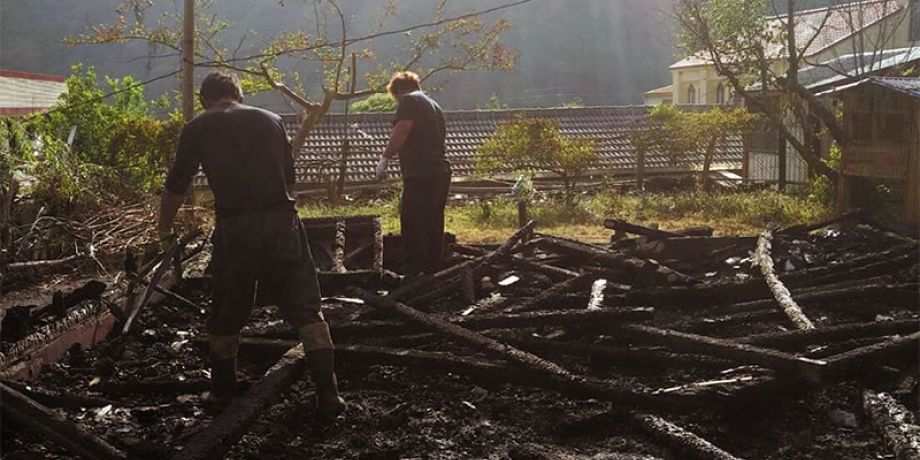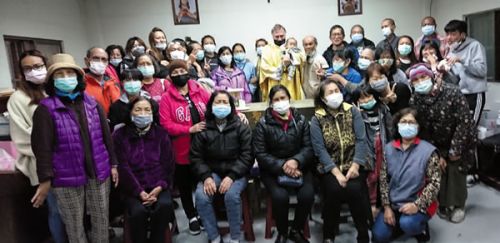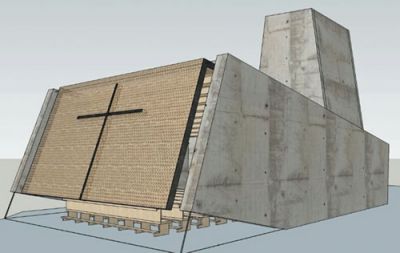
God Will Provide in the Midst of Disaster
The phone woke me from a deep sleep. I turned on the light. The clock read 2:35 a.m., and the caller was Saiyun, a church leader in DaGuan village. Her mother is elderly and in poor health. I thought something had happened to her mother, and I answered the call. “Father, the church has burned down,” Saiyun said through sobs and tears. I thought I had misheard and asked her to repeat the message. Sure enough it was true. The chapel in DaGuan village was no more.

DaGuan is part of the eight village DaAn pastoral area of Hsinchu Diocese, Taiwan, where myself, Columban Fr. Taaremon Matauea and lay missionary Bae SiHyeon work with the parish secretary/social worker and a full-time local catechist. The pastoral area, in the mountains along the DaAn River, is split between two dioceses, and DaGuan village is part of the neighboring TaiZhong Diocese.
The chapel was a small, wood structure built by a Maryknoll priest 65 years ago. He supplied the materials and village men built the chapel in a design typical of the Japanese colonial period (1895-1945). The chapel could seat 60, had carved wood Stations of the Cross, hardwood pews, and an ambo (lectern) made of a solid piece of hardwood cedar tree trunk. It had a piano and electric keyboard. Behind the sanctuary wall was a sacristy and a small room for the priest to stay overnight. All that was left after the fire was the concrete pad on which the chapel was built and the remains of the brass tabernacle reduced to a metal ball the size of a baseball. It was heartbreaking. A police investigation concluded that the fire started from a wall-socket where the electric tabernacle light was plugged in.

In the aftermath of the fire and the shock of it for the Catholic members of the village, the regular Mass-goers gathered to take stock. I was deeply impressed with their faith in the face of the tragedy. They spoke about the good things and thanked God for the graces that came with the disaster.
The fire was only noticed when one parishioner got up to use the toilet and woke her husband who saw the smoke rising from the chapel in the village below their house. They called others and then raced down to the church. The wife attempted to enter the chapel to rescue the Blessed Sacrament but was restrained by her husband who could see the roof ablaze and knew the rescue was impossible. The Pastor of the Presbyterian Church near the chapel woke to the smell of smoke and raced over to help. Knowing that there was a gas canister in the kitchen complex adjacent to the burning church and knowing the danger if it exploded, he ran into the smoldering building and dragged the canister to a safe distance.
In examining the devastation, parishioners talked about how it was a good opportunity to clarify problems over chapel land boundaries, the title on electricity supply, and getting a more secure water supply to the site. They quickly established a roster of families to host Sunday Mass and said it was a way to strengthen the faith of villagers and encourage them to be more active in their faith. They immediately started a village collection of funds to repair the meeting room/kitchen/toilet building on the site so that Mass could quickly resume there.

is the child's mother with Columban Lay Missionary Bae Sihyeon
who is the baby's godmother.
It has been over a year since the fire. The villagers have cleaned the site, and we held the 2019 combined eight-village parish Christmas celebration there under tents to kickstart fundraising for a new chapel. The parishioners and local Diocesan Dean have agreed on a design and a budget, and the local Bishop has given his permission to start fundraising. They accepted an architect’s design that imitates the rocks and mountains of the place and gives a feeling of solid strength that reflects the cultural personality and faith of the local Atayal indigenous people. The design includes a church, sacristy, and sleeping quarters for the priest, parking area and a new kitchen/toilet/meeting room complex. The budget is set at $270,000. The diocese will try to raise the bulk of the cost, and the Dean is already reaching out to funding agencies. However, the villagers must themselves raise the sum of $70,000 for furnishing and decorations. This will be a difficult task for the 30 Catholic families in the village who rely on their fruit orchards and bamboo shoot harvest annually for income. They are already discussing ways and means, and I am sure they would be grateful for any assistance in reaching their goal.
The ladies of the village are all good singers and our weekly Mass in the village, held now in a variety of settings, is full of spirit as the ladies give voice to their faith that God will provide even in midst of disaster. Their faith is strength and encouragement to this Columban missionary, and I thank God daily for the privilege of ministering among such a people.
Columban Fr. Larry Barnett lives and works in Taiwan.